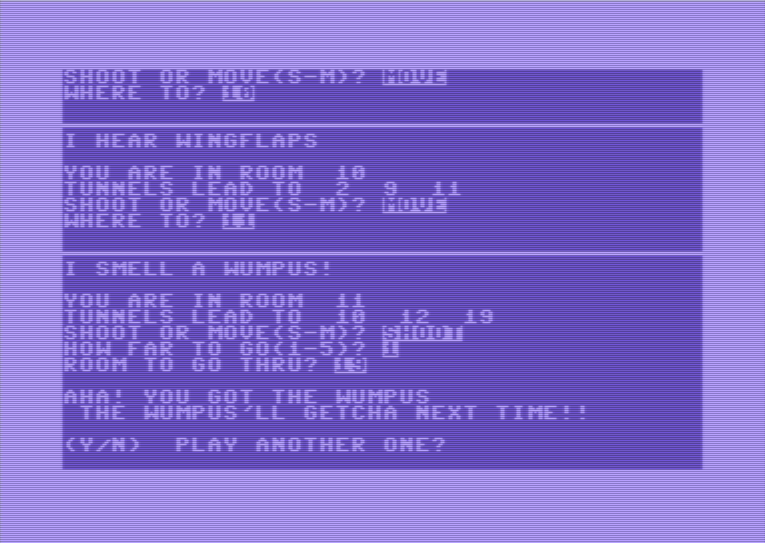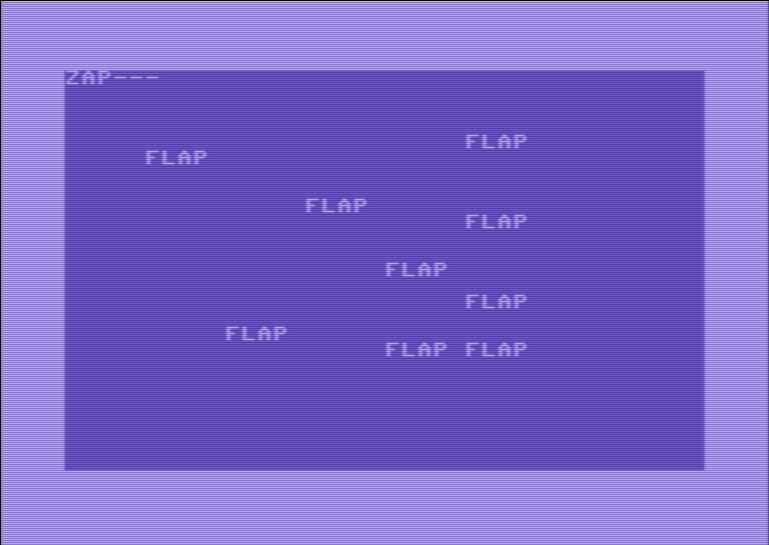1973 - Hunt the Wumpus
And we’re back, with some delay. After the last couple forays into the world of early commercial video games, we’re diving into the other half of the early industry: hobbyist programmers. Money may have eventually become the future of the industry, but in my opinion the more interesting stuff at this point was being done by people just having fun with their machines. This time, it’s Hunt the Wumpus, our first text-based game. Though the game was (according to Wikipedia) developed in 1973, I played the 1977 version published by Creative Computing, previously playable over at the Internet Archive. The in-browser play may or may not be working at the moment, depending on when you read this, but all the files should still be there.
Hunt the Wumpus is a text adventure where you explore a maze of caves in search of a monster called (surprise) the Wumpus. You have a bow, five arrows, and your senses. The Wumpus has claws, teeth, and a foul odor. The caves are arranged in a dodecahedron (something the game tells you right away so you don’t start thinking that it’s the weirdest square grid ever), each cave has a number, and you can move between adjacent caves, but it’s too dark to see what’s in them before you enter them. This is a problem, because the caves contain not only the Wumpus, but a couple other hazards: falling into a pit will kill you immediately, and Super Bats will move you to a random cave. Being in the same room as the Wumpus will also get you killed. You can, however, detect that something is in an adjacent room, just not which room they’re in – you can hear bats, feel a draft from pits, and smell the Wumpus.

Gameplay, as seen on the Internet Archive's in-browser emulator. Including me winning the game!
The only way you can attack the Wumpus is by firing your bow. You’ve got five “crooked arrows,” a special sort of arrow that you can curve mid-flight. What this actually means, in gameplay, is that you pick which rooms the arrow enters in order. If it hits the Wumpus, you win! If you miss, the Wumpus is startled, it moves one room in a random direction. If that means it moves into you, you lose. And, of course, if you manage to hit yourself with an arrow, you also lose. The meat of the game, for me, was in mapping out the cave without running into any of the hazards, figuring out their locations when I could detect them from multiple rooms. It’s pretty easy with a pen and paper, but holding it all in your head is a bit more of a challenge. I had a fun time with it, but once I had the process of ferreting out the Wumpus down there just wasn’t much else to do with it.

The map I drew of the room layout, flattened down to 2D since drawing a 3D dodecahedron would've been a little impractical.
This wasn’t a game I’d heard of at all before looking up games for 1973, but I’ve been told (mostly by Wikipedia) that it’s quite influential. Apparently it’s even the first survival horror game. I can’t say I see that, myself. It’s a game of hide-and-seek, sure, but you’re doing the seeking, and it’s not like anything in the game is really trying to be scary. To me, the game seems to have a lot more in common with later text adventures than with anything else. The room-based gameplay with very limited information on other rooms, heavy focus on an unconventional map layout, and sudden deaths make this feel like a distant ancestor of future text adventures.

Getting abducted by Super Bats plays a little animation where the screen fills with the word "flap." Screenshot by me.
I liked Hunt the Wumpus, but there just wasn’t that much to it. Once I’d solved the puzzle once, it was pretty easy to solve it any other time. There weren’t enough moving pieces for the game to be that interesting on replays. Still, it was neat to see one of the earliest text-based games, and the actual process of solving the game was fun – I’m always up for drawing my own map. It’ll be interesting to see if I can feel its influence in any upcoming text adventures. Next time, we’re moving on to 1974. Goodbye, Nixon.